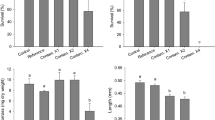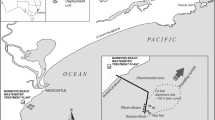Abstract
Synthetic-based drilling muds (SBMs) offer excellent technical characteristics while providing improved environmental performance over other drilling muds. The low acute toxicity and high biodegradability of SBMs suggest their discharge at sea would cause minimal impacts on marine ecosystems, however, chronic toxicity testing has demonstrated adverse effects of SBMs on fish health. Sparse environmental monitoring data indicate effects of SBMs on bottom invertebrates. However, no environmental toxicity assessment has been performed on fish attracted to the cutting piles. SBM formulations are mostly composed of synthetic base oils, weighting agents, and drilling additives such as emulsifiers, fluid loss agents, wetting agents, and brine. The present study aimed to evaluate the impact of exposure to individual ingredients of SBMs on fish health. To do so, a suite of biomarkers [ethoxyresorufin-O-deethylase (EROD) activity, biliary metabolites, sorbitol dehydrogenase (SDH) activity, DNA damage, and heat shock protein] have been measured in pink snapper (Pagrus auratus) exposed for 21 days to individual ingredients of SBMs. The primary emulsifier (Emul S50) followed by the fluid loss agent (LSL 50) caused the strongest biochemical responses in fish. The synthetic base oil (Rheosyn) caused the least response in juvenile fish. The results suggest that the impact of Syndrill 80:20 on fish health might be reduced by replacement of the primary emulsifier Emul S50 with an alternative ingredient of less toxicity to aquatic biota. The research provides a basis for improving the environmental performance of SBMs by reducing the environmental risk of their discharge and providing environmental managers with information regarding the potential toxicity of individual ingredients.






Similar content being viewed by others
References
Aas, E., Beyer, J., & Goksoyr, A. (1998). PAH in fish bile detected by fixed wavelength fluorescence. Marine Environmental Research, 46, 225–228.
Amanullah, Md. (2006). Screening and evaluation of some environment friendly mud additives to use in water based drilling muds. In: SPE-98054-PP presented at the SPE International Conference on Health, Safety and Environment in Oil and Gas Exploration and Production, Abu Dhabi, UAE, 2–4 April 2006.
Anderson, J. W., Neff, J. M., Cox, B. A., Tatem, H. E., & Hightower, G. M. (1974). Characteristics of dispersions and water-soluble extracts of crude and refined oils and their toxicity to estuarine crustaceans and fish. Marine Biology, 27, 75–88.
APHA-AWWA-WEF 2005. Method 5520F, hydrocarbons: standard methods for the examination of water and wastewater/prepared and published jointly by American Public Health Association, American Water Works Association and Water Environment Federation. 21st Edition.
Bakhtyar, S., & Gagnon, M. M. (2009). Biomarker response of pink snapper to chronic exposure to synthetic-based drilling muds. Environmental Bioindicator, 4, 136–152.
Boethling, R. S., Sommer, E., & DiFiore, D. (2007). Designing small molecules for biodegradability. Chemical Reviews, 107, 2207–2227.
Carls, M. G., & Rice, S. D. (1984). Toxic contributions of specific drilling mud components to larval shrimps and crabs. Marine Environmental Research, 12, 45–62.
Fairbrain, D., Meyers, D., & O’ Neill, K. L. (1994). Detection of DNA damaging agent in environmental water samples. Bulletin of Environmental Contamination and Toxicology, 52, 687–690.
Friedheim, J. E. & Conn, H. L. (1996). Second generation synthetic fluids in the North Sea: are they better? In: SPE 35061, Proc. IADCISPE Drilling Conference, New Orleans, 12–15 March.
Gagnon, M. M., & Holdway, D. A. (1998). MFO induction in Atlantic salmon (Salmo salar) during and after exposure to Bass Strait crude oil. Australasian Journal of Ecotoxicology, 4, 29–35.
Hawker, D. W., & Connell, D. W. (1985). Relationships between partition coefficient, uptake rate constant, clearance rate constant, and time to equilibrium for bioaccumulation. Chemosphere, 14, 1205–1219.
Hawker, D. W., & Connell, D. W. (1986). Bioconcentration of lipophilic compounds by some aquatic organisms. Ecotoxicology and Environmental Safety, 11, 184–197.
Heath, A. G. (1995). Water Pollution and Fish Physiology (2nd ed.). Florida: CRC. 359.
Hodson, P. V., Kloepper-Sams, P. J., Munkittrick, K. R., Lockhart, W. L., Metner, D. A., Luxon, P. L., et al. (1991). Protocols for measuring mixed function oxygenases of fish liver. Canadian Technical Report of Fisheries and Aquatic Sciences 1829 (p. 51). Canada: Department of Fisheries and Oceans.
Holdway, D. A., Brennan, S. E., & Ahokas, J. T. (1994). Use of hepatic MFO and blood enzyme biomarkers in sand flathead (Platycephalus bassensis) as indicators of pollution in Port Phillip Bay, Australia. Marine Pollution Bulletin, 26, 683–695.
Konca, K., Lankoff, A., Banasik, A., Lisowska, H., Kuszewski, T., Gozdz, S., et al. (2003). A cross-platform public domain PC image-analysis program for the comet assay. Mutation Research, 534, 15–20.
Krahn, M. M., Rhodes, L. D., Myers, M. S., Macleod, W. D., & Malins, D. C. (1986). Association between metabolites of aromatic compounds in the bile and the occurrence of hepatic lesions in English sole (Parophyrus vetulus) from Puget Sound, Washington. Archives of Environmental Contamination and Toxicology, 15, 61–67.
Levine, G. A., Bissell, M. J., & Bissell, D. M. (1978). Conversion of glucose to sorbitol and fructose by liver-derived cells in culture. Journal of Biological Chemistry, 17, 5985–5989.
Lin, E. L. C., Cormier, S. M., & Torsella, J. A. (1996). Fish biliary polycyclic aromatic hydrocarbon metabolites estimated by fixed-wavelength fluorescence: comparison with HPLC-fluorescent detection. Ecotoxicology and Environmental Safety, 35, 16–23.
Lowry, O. H., Rosebrough, N. J., Farr, A. L., & Randall, R. J. (1951). Protein measurement with the Folin phenol reagent. Journal of Biological Chemistry, 193, 265–275.
Macdonald, M. J., Shields, J. D., & Zimmer-Faust, R. K. (1988). Acute toxicities of eleven metals to early life-history stages of the yellow crab (Cancer anthonyi). Marine Biology, 98, 201–207.
Neff, J. M. (2005). Composition, environmental fates, and biological effect of water based drilling muds and cuttings discharged to the marine environment, In: A synthesis and annotated bibliography. Prepared for Petroleum Engineering Research Forum (PERF) and American Petroleum Institute, pp.73.
Neff, J. M. (2008). Estimation of bioavailability of metals from drilling mud barite. Integrated Environmental Assessment and Management, 2, 184–193.
Neff, J. M., Rabalis, N. N., & Boesch, B. F. (1987). Offshore oil and gas development activities potentially causing long-term environmental effects. In: Long term environmental effects of offshore oil and gas development. London: Elsevier Applied Science, pp 149–173.
Neff, J. M., McKelvie, S., & Ayers, R. C., Jr. (2000). Environmental impacts of synthetic based drilling fluids. OSC Study MMS 2000–064. U.S (p. 121). New Orleans: Department of the Interior, Minerals Management Service, Gulf of Mexico OCS Region.
NRC. (1983). Drilling discharges in marine environment. Washington: National Research Council National Academy. 180.
Palace, V. P., Klaverkamp, J. K., Lochart, W. L., Metner, D. A., Muir, C. G., & Brown, S. B. (1996). Mixed function oxidase enzyme activity and oxidative stress in lake trout (Salvelinus namaycush) exposed to 3,3′,4,4′,5-pentacholorobiphenyl (PCB-126). Environmental Toxicology and Chemistry, 15, 955–960.
Patin, S. A. (1999). Environmental impacts of the offshore oil and gas industry (1st ed.). New York: EcoMonitor Publishing East Northport.
Patin, S. A. & Lesnikov, L. A. (1988). Main principles of establishing the fisheries standards for the water environment quality. In: Methodical guidelines on establishing the maximum possible concentrations of pollutants in the water environment. Moscow: VNIRO, pp. 3–10.
Payne, J. F., Fancey, L. L., Rahimtula, A. D., & Porter, E. L. (1987). Review and perspective on the use of mixed function oxygenase enzymes in the biological monitoring. Comparative Biochemistry and Physiology, 86C, 233–245.
Rye, H., Nordtug, T., Tobiesen A., Osteorot A. (1997). Drilling and well chemicals and their environmental impacts. A survey of amounts, ecotoxicological properties, dispersion and impacts in the marine environment. Paper in ‘Chemistry in the Oil Industry' 6th International Symposium. Ambleside, The Lake District, UK. 14–17 April, 1997. The Royal Society of Chemistry, London, UK. pp. 21.
Singer, M. M., Aurand, D., Bragin, G. E., Clark, J. R., Coelho, G. M., Sowby, M. L., et al. (2000). Standardization of the preparation and quantitation of water-accommodated fractions of petroleum for toxicity testing. Marine Pollution Bulletin, 40, 1007–1016.
Singh, N. P., McCoy, M. T., Tice, R. R., & Schneider, E. L. (1988). A simple technique for quantitation of low levels of DNA damage in individual cells. Experimental Cell Research, 175, 184–191.
Starczak, V. R., Fuller, C. M., & Butman, C. A. (1992). Effects of barite on aspects of the ecology of the polychaete Mediomastus ambiseta. Marine Ecology Progress Series, 3, 269–282.
Swan, J. M., Neff, J. M., & Yong, P. C. (1994). Environmental implication of offshore oil and gas development in Australia. The finding of an independent scientific review (p. 696). Sydney: Australian Petroleum exploration Association Limited.
Travlos, G. S., Morris, R. W., Elwell, M. R., Duke, A., Rosenblum, S., & Thompson, M. B. (1996). Frequency and relationships of clinical chemistry and liver and kidney histopathology findings in 13-week toxicity studies in rats. Toxicology, 10, 17–29.
Tsvetnenko, Y., & Evans, L. (2002). Improved approaches to ecotoxicity testing of petroleum products. Marine Pollution Bulletin, 45, 148–156.
USEPA. (1986). Method 3510, separatory funnel liquid–liquid extraction, In: SW-846, test methods for evaluating solid waste, physical/chemical methods. Third Edition, September 1986. United States Environmental Protection Agency, OSWER, Washington, DC.
USEPA. (2001a). Method 200.7, trace elements in water, solids, and biosolids by inductively coupled plasma-atomic emission Spectrometry. Washington: United States Environmental Protection Agency, Office of Science and Technology.
USEPA. (2001b). Method 245.2, mercury in water by automated cold vapour atomic absorption (CVAA). Washington: United States Environmental Protection Agency, Office of Science and Technology.
USEPA. (2002). Method 821-R-02-013., short terms methods for estimating the chronic toxicity of effluents and receiving water to freshwater organisms (4th ed.). Washington: United States Environmental Protection Agency, Office of Water. October 2002.
USEPA, (2006). Method 8270 C, semi-volatile organic compounds by gas chromatography/mass spectrometry (GC/MS), revision 3 December 1996. In: SW-846, test methods for evaluating solid waste, physical/chemical methods. Washington, DC: United States Environmental Protection Agency, Office of Solid Waste
Van der Oost, R., Beyer, J., & Vermeulen, N. P. E. (2003). Fish bioaccumulation and biomarkers in environmental risk assessment: A review. Environmental Toxicology and Pharmacology, 13, 57–149.
Webb, D., & Gagnon, M. M. (2007). Serum sorbitol dehydrogenase activity as an indicator of chemically induced liver damage in black bream (Acanthopagrus butcheri). Environmental Bioindicators, 2, 172–182.
Webb, D., & Gagnon, M. M. (2009). The value of stress protein 70 as an environmental biomarker of fish health under field conditions. Environmental Toxicology, 24, 287–295.
Acknowledgments
The present study was supported by the Australian Research Council, Linkage Program, via a grant to MMG, and by Santos Ltd and Rheochem Ltd. The authors want to express their gratitude to Fremantle TAFE and Aquatic Sciences Curtin University staff for their continuous support including supply and handling of pink snapper. We also want to thank Ting Chen from Rheochem Ltd for his continuous support, advice, and for supplying the drilling mud ingredients and mud systems. The authors extend their thanks to the staff of National Measurement Institute (NMI), WA, for their support in chemical analysis.
Author information
Authors and Affiliations
Corresponding author
Rights and permissions
About this article
Cite this article
Bakhtyar, S., Gagnon, M.M. Toxicity assessment of individual ingredients of synthetic-based drilling muds (SBMs). Environ Monit Assess 184, 5311–5325 (2012). https://doi.org/10.1007/s10661-011-2342-x
Received:
Accepted:
Published:
Issue Date:
DOI: https://doi.org/10.1007/s10661-011-2342-x




